Here at HDTVTest, we’re big fans of OLED TVs, especially with plasma now truly dead and buried, mainly because of the true blacks and awesome contrast OLED technology is capable of producing thanks to its self-emitting properties. For this reason, we unequivocally applaud LG Electronics for daring to push ahead with its OLED television models at a time when no other major TV brands are doing so (although, of course, the fact that LG holds the patent to the only commercially viable large-screen OLED panel technology at this moment played a big part in this turn of events).
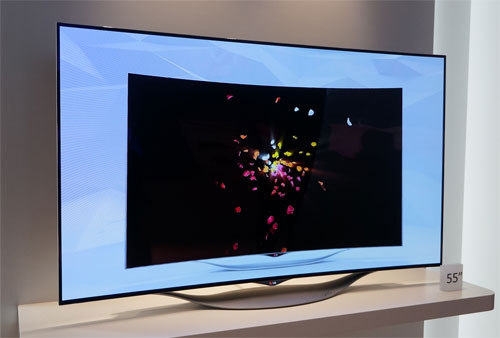
Which takes us to the LG 55EC930V, the Korean manufacturer’s second-generation 55-inch full HD 1080p curved OLED TV that carries an eminently affordable price tag of only £1,999 at this time of writing (a far cry from the £7,999 launch price of its predecessor the 55EA980W). When we reviewed the equivalent USA model some two months ago, we loved its black level and contrast performance, but pointed out several flaws with the display’s video processing and calibration controls, one of which – namely forced noise reduction – was debated so heatedly among the video enthusiast community that the issue unfortunately became blown out of proportion. With this UK version, we’d like to take stock and assess its picture quality as a whole, while paying particular attention to the previously noted issues to see if they persist or have been improved by firmware updates.
Note: This entire review was conducted with our sample running on software version 04.32.20, the latest at time of publication.
Design
No matter how many times we’ve laid eyes on LG’s OLED television, it never fails to draw a gasp from us, what with its razor-thin panel measuring only 5mm in depth. A thicker compartment is tacked onto the rear of the chassis, housing the EC930V’s video processing components and connection ports. The screen is curved, but subtly so, and it’s tastefully offset by a newly-designed “leaf” stand whose convex base sort of neutralises the panel’s concavity. With the set switched off, we noticed a few uneven dimples on the front layer when inspected off-angle: fortunately this did not affect real-life viewing at all.
Calibration
To obtain accurate measurements from OLED’s narrow spectral power of distribution (SPD), we profiled our resident Klein K10-A meter against a JETI Specbos 1211 reference-class spectroradiometer. The signal generator and calibration software used were DVDO’s AVLab TPG and SpectraCal’s CalMAN Ultimate version 5.4 respectively.
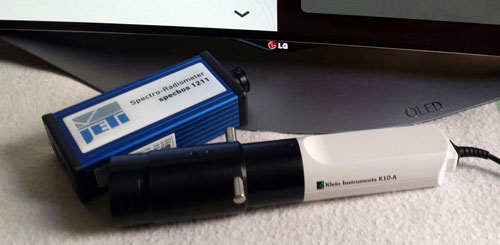
Greyscale
Heeding advice from LG’s senior engineers, we aligned several settings on our 55EC930V sample to their requisite values (or else the 20-point white balance controls would misfire) before proceeding to calibrate greyscale. We first used the two-point (including [Low, Blue] which skewed blue accuracy on the American EC9300 model) then the 20-point [White Balance] controls, and it appeared that LG has fixed the problematic controls perhaps by way of a firmware update.
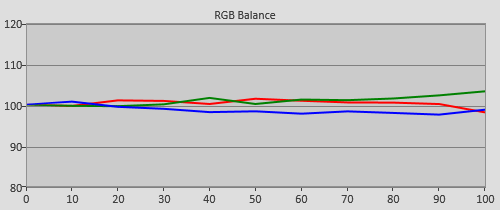 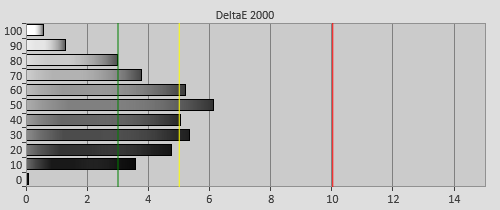 |
| Pre-calibration RGB tracking and delta errors (dEs) |
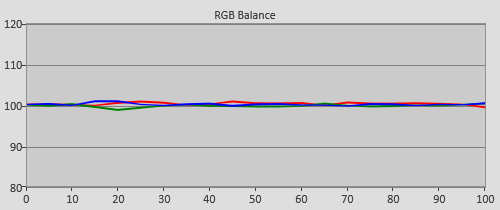 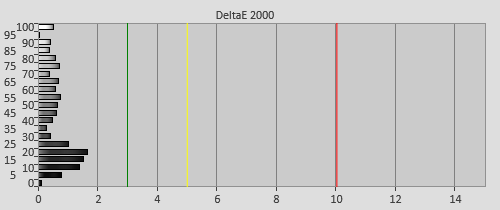 |
| Post-calibration RGB tracking and dEs in [ISF Expert] mode |
The actual calibration process itself remained laborious (not helped by us having to exit the menu to cross-check against greyscale and colour ramps from time to time), but we didn’t observe any significant increase in posterization in both test patterns and real-world material.
Gamma
The EC930V’s highest [Gamma] setting of “2.4” only yielded an overall gamma of 2.23. Given OLED’s industry-leading dynamic range, it would be a crying shame having to put up with 2.2 or even lower gamma which looks like an overexposed, washed-out photo to our eyes.
![Pre-calibrated Gamma tracking in [ISF Expert] mode](/news/wp-content/uploads/2018/04/hdtv_LG-55EC930V_pre-gamma.png) |
![Post-calibrated Gamma tracking in [ISF Expert] mode](/news/wp-content/uploads/2018/04/hdtv_LG-55EC930V_post-gamma.png) |
| Pre-calibration gamma tracking (2.13) | Post-calibration gamma tracking (2.37) |
Using the onboard 20p WB controls which worked well but only if adhering to tips from LG’s engineers, we adjusted point gamma at every 5% stimulus interval to 2.4 for midtones and highlights, while aligning near-black gamma to between 2.1 and 2.2 to prevent shadow detail from being obscured.
Colour
LG has included a tri-axis colour management system (CMS) on the 55EC930, which provides [Saturation], [Tint] and [Luminance] controls for all six primary (red, green, blue) and secondary (cyan, magenta, yellow) colours. As is the case with most TVs from the South Korean brand, CMS adjustments needed to be made very gently, or else large swings in errors would ensue.
![Post-calibration Colour saturation tracking in [ISF Expert] mode](/news/wp-content/uploads/2018/04/hdtv_LG-55EC930V_post-strack.jpg) |
| Post-calibration colour saturation tracking |
Thankfully, most of the measured saturation tracking points fell into place after greyscale calibration, meaning that we didn’t need to call upon the CMS much at all.
![Post-calibration colour errors in [ISF Expert] mode](/news/wp-content/uploads/2018/04/hdtv_LG-55EC930V_post-strack-de.png) |
| Post-calibration colour errors (<3 not appreciable to the eye) |
Benchmark Test Results
| Dead pixels | None |
| Screen uniformity | Some colour tint along sides & near-black vignetting |
| Overscanning on HDMI | 0% with [Aspect Ratio] set to “Just Scan“ |
| Blacker than black | Passed |
| Calibrated black level (black screen) | 0 cd/m2 |
| Calibrated black level (4×4 ANSI) | 0.0004 cd/m2 |
| Black level retention | Very mild – generally not visible outside test sequence |
| Primary chromaticity | Very good |
| Scaling | Very good |
| Video mode deinterlacing | Very effective jaggies reduction |
| Film mode deinterlacing | Passed 3:2 & 2:2 cadence tests in SD & HD |
| Viewing angle | Very good, but green tint off-axis |
| Motion resolution | 600 with [TruMotion] engaged; 300 otherwise |
| Digital noise reduction | Stripping of fine detail except in 60Hz [PC] mode |
| Sharpness | Defeatable edge enhancement |
| Luma/Chroma bandwidth (2D Blu-ray) | Full Luma; Chroma horizontally blurred |
| 1080p/24 capability | No judder in 2D or 3D with [Real Cinema] engaged |
| Input lag (high-speed camera) | 31ms in [PC] mode |
| Leo Bodnar input lag tester | 39ms in [PC] mode |
| Full 4:4:4 reproduction (PC) | Yes, with input label set to [PC] |
Power Consumption
| Default [Eco] mode | 111 watts |
| Calibrated [ISF Expert1] mode | 73 watts |
| Standby | <1 watt |
Picture Quality
Black Level & Contrast Performance
With an OLED TV like the LG 55EC930V, where else to start but to comment on its otherworldly, 0 cd/m2 blacks whose impact on even the most mundane of viewing cannot be overstated. When paired with 2.4 gamma (painstakingly attained through 20-point white balance tweaks), it lent a formidable scale of richness and depth to whatever was displayed on screen, eclipsing even the best plasmas.
Whereas the legendary Pioneer Kuros and Panasonic’s swansong ZT plasma would still exhibit precharge glow on a full-field video black pattern in a dark room, the LG OLED emitted no light at all, as if it’s switched off even though it’s on. And different from LED LCD televisions which can shut down their backlight on a full-black screen, the 55in EC930V was able to maintain its zero-emission blacks in the presence of brighter elements on screen. No other display tech can outdo OLED on black-level performance, period.

The 55EC930V was no slouch either at the other end of the contrast ratio spectrum. Yes, there’s Automatic Brightness Limiter (ABL) at play, but on the whole it’s less aggressive than that found on plasma display panels (PDPs). With [OLED Light] and [Contrast] cranked up to the maximum value of “100“, we measured light output to be 93 cd/m2 and 356 cd/m2 on a full-field 100% white and a corresponding windowed pattern respectively. Put another way, there’s plenty of light reserve for even the most demanding of home cinema applications.
For the sake of completeness, we ought to mention that perhaps as a built-in protective mechanism, the LG curved OLED would automatically dim its screen in gradual steps after a static image was displayed for some time, and if a dark-enough threshold was reached, the algorithm would go “dim, bright, dim” at regular intervals. While this had the most ramifications during calibration (we had to cycle through patterns and input sources frequently to “refresh” the luminance output), it never troubled us in real-life content.
Screen Uniformity
Once we peeled our eyes away from the addictive contrast and started to analyse critically though, we unearthed a number of interesting issues on the EC930 OLED. First was the presence of varying degree of discolouration on different parts of the screen, notably a magenta tint along the left and right sides on our review unit. This was compounded by the image taking on a slight greenish cast when not viewed straight on. Whilst this tinting was largely invisible with most content we watched, black-and-white films and a uniform grey/white backdrop would show it up, which may irk owners depending on their viewing habits and individual tolerances.
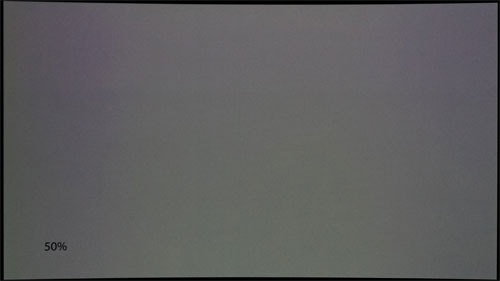 |
| Magenta tint along the sides on a 50% stimulus full-field grey pattern |
Besides the uneven colour tinting, there was one other uniformity issue on our 55″ EC930V sample. When we loaded Chapter 12 of Harry Potter and The Deathly Hallow Part 2 to assess black level and shadow detail, we immediately noticed the sides appearing a fair bit darker than the centre of the screen, obliterating detail in those areas. Here’s a photo capture to illustrate:
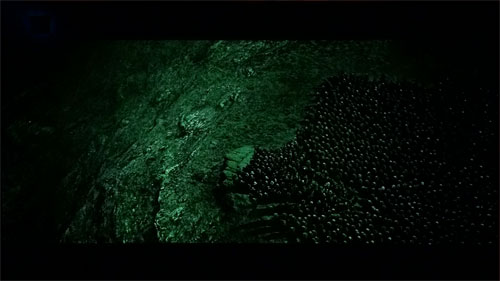 |
| Loss of detail along the left and right edges in a low-APL scene |
Intrigued, we fed some full-screen near-black patterns to the 55EC930V, and saw the same vignetting effect:
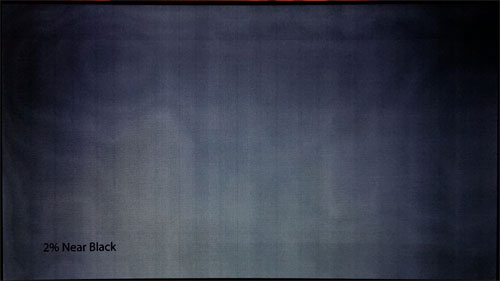 |
| Low-APL vignetting on a full-field 2% above black pattern |
We experimented with various user menu options including [HDMI Black Level] and [PC] mode, and the only way to restore the lost detail was by raising [Brightness] much higher than 16 video black, which of course destroyed the inky blacks and washed out the entire image. To be fair, the vignetting effect was only visible in super-low-APL sequences and not in brighter scenes: in test pattern parlance, we didn’t see it beyond full-field 4% above black. Our review unit was well run-in (126 hours according to the inbuilt counter), but we cannot rule out the possibility (however remote) that it may improve with further use and/or a firmware update.
Motion
Despite sample-and-hold being a major contributor to motion blur as we perceive it, LG has told HDTVTest that it doesn’t see the need for black frame insertion (BFI) on the company’s OLED TV since “it’s a self-emission display, and has enough response time”. This stance is hardly surprising, given that the Seoul-headquartered television maker doesn’t even have a history of implementing BFI on its LED LCD TVs over the years.
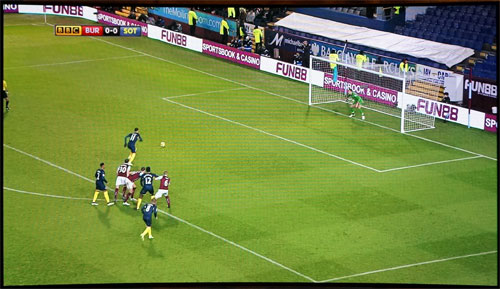
That said, fast-paced live sports broadcast like football still looked quite watchable on the 55EC930, owing to OLED’s clean pixel response and mesmerising colours/ contrast. Engaging [TruMotion] doubled motion resolution (as determined via the horizontally scrolling lines in Chapter 31 of the FPD Benchmark Software test disc) from a baseline of 300 to 600.
Among the [TruMotion] settings, we preferred customising the “User” option with separate [De-Judder] and [De-Blur] values, instead of using the stock “Clear” and “Smooth” options which introduced some interpolation artefacts and soap opera effect to 24fps movies. We did spot the odd stutter with [TruMotion] enabled, as the motion processing kicked in during scene changes.
Resolution
The LG EC930V features a somewhat different subpixel layout from the company’s first-gen OLEDs, and the relatively low pixel-fill ratio coupled with the polarized 3D filter’s horizontal scanlines made the 1080p pixel grid more obvious, causing us to yearn for 4K Ultra HD versions.
![]()
The always-on noise reduction (which was dissected extensively in our review of the US-designated 55EC9300) remained present on the British model, and although we concede that most viewers will probably never see it (mostly because they don’t know what to look for), it would be nice of LG to provide a fully-working “Off” switch in the interest of video fidelity.
3D
The 55EC930V ships with two pairs of polarized 3D glasses, as well as two pairs of clip-ons that will delight bespectacled users (nice touch, LG!). 3D looked as good as a non-4K passive 3D display could do, with the OLED’s stunning black level and punchy contrast imparting a captivating sense of depth and immersiveness that we’ve never witnessed on lesser IPS-based 3DTVs. The traditional strengths of passive 3D technology – namely absent flicker, minimal crosstalk, bright images and vibrant colours – translated into a relaxing yet engaging extra-dimensional viewing experience.
Our only gripe was the halved vertical resolution (an unavoidable side effect of passive 3D systems) – OLED’s innately high contrast seemed to bring the horizontal scanlines and jagged edges to the fore. Again, 4K UHD (ultra high-definition) OLED television can’t come soon enough.
Gaming
The LG EC930V was a joy to game on – the inherently fast pixel response time of OLED technology meant that motion looked supremely clean, free of any black smearing, afterglow trails and overdrive errors which affect even the best LCDs and plasmas.

Using a Leo Bodnar device, we measured input lag to be 39ms in [PC] mode (pro tip: disable the internal TV speakers to shave off a couple more miliseconds), 49ms in [Game] mode, and 106ms in [ISF Expert1] mode with [TruMotion] enabled. Eye-popping contrast and lush colours were icing on the cake.
Verdict
We might have spent a number of paragraphs highlighting certain shortcomings on the LG 55EC930V, but that doesn’t mean it’s a bad display. On the contrary, every new OLED TV to hit the market – especially one as affordable as this one – will be scrutinised to death precisely because it has the potential to be the best television ever.
No TV is perfect, and let’s not pretend that PDP and LCD TVs – which have taken decades to mature into the ubiquitous display technologies we see today – are without flaws. Plasma suffers from image retention (which if left unattended may lead to permanent screenburn), high-APL buzzing, dynamic false contouring (DFC), PWM (pulse-width modulation) noise and ABL-capped light output; whereas LCD is hampered by black level, backlight uniformity, viewing angle and motion quality.
It’s worth remembering that the EC930V is only LG’s second iteration of a 55-inch curved OLED television: it’s got an ideal platform of unrivalled blacks from which to deliver gorgeous images, and some of the described issues can potentially be rectified via firmware updates (to improve picture processing) or an outboard 3D LUT solution like the Lumagen Radiance series of video processors (which we will be exploring). If you have £2,000 to spend, and absolutely have to buy a new TV at this time of writing, then the LG 55EC930V deserves a place on your audition shortlist.



Thanks for an interesting review. How can LG refer to this tv as “The Ultimate Display” ! A month ago I went along to Richer Sounds for a demo of this tv, taking along a Blu-ray, Into the Wild. Viewing the snowy landscape of this Blu-ray, it didn’t take me long to notice the terrible screen uniformity, as you have shown here. the snow took on what I would call “A rainbow effect”! Terrible!
Yes the tv has superb blacks and contrast, but having to put up with awful bad screen uniformity aint for me! There are a lot of customer complaints regarding this issue on the US AVS Forum.
Thanks, until LG can offer better than that I will stick with my Sony KDL46HX923 with its full array backlight & local dimming, giving cloudless deep inky blacks & superb screen uniformity.
Question for John Bagley.
What was your post calibration settings please???
You do your reviews and the site an injustice when you give a highly recommended award to a television which features an always on noise reduction feature, a feature which you mention strips away the finest detail.
I just don’t see how you can give out such an award or even recommend the television because of that.
The uniformity issues and vignetting are problems too, it seems black levels are great, so what, there are other problems which would frankly drive me nuts if i was to spend this sort of money on a television.
OLED is not ready for prime time just yet.
Question for Vincent Teoh.
What were your post calibration settings???
Just an E.mail reply, no need to post on your ‘comments’
Much appreciated
stefan
Seems all about black levels again, Dnr stripping fine detail doesn’t sound good but the Gamma looks good, very similar looking to BT.1886.
Expensive, 2-3 years lifespan OLED with uniformity and black crush issues.
No calibration settings from hdtvtest ? Because they don’t want to show it and say that “it won’t calibrate your TV”.
But they didn’t listen to the request. They just invent excuses for their refusal to care about their readers.
Thanks for the review, Vincent.
Have to 2nd what was said above. In contrast to the DNR the green/red tint uniformities issues are visible for everyone who like to watch winter sports, B/W movies or whatever else with bright screens. Not acceptable and the one thing that LG absolutely needs to work on. I am very disappointed after confirming it myself.
Did you measure the input lag by BOTH renaming the HDMI port to the PC label (drop down menu) and enabling game mode at the same time? David didn’t seem to know about it, so just making sure.
Lol so much crap in the comments section …
@FoxyMulder – not sure what you mean by OLED is not ready for prime time just yet. As the review points out both plasma and LCD’s have had decades to mature and still are far from perfect. Do you expect LG to fully master OED while the technology is still in it’s infacy??? These quirks will only be ironed out by first finding them and secondly sorting them in every new release.
@crac – you sound suspiciously like the user who has been going out spouting absolute garbage about OLED technology. The 2-3 year life span starter is a complete and utter give away …
@jjames
I expect a television review site to not give out highly recommended badges to televisions which clearly don’t deserve them.
Who wants to pay £2000 for a TV with serious issues when as you rightly point out you can buy other types of televisions which have had their quirks ironed out, this wouldn’t be so bad if LG would confirm they are working on firmware to fix the issues but unless we know that is the case then i don’t see how anyone except those with money to burn would buy one of these sets.
You talk about sorting out the issues and say OLED is in it’s infancy, yes it is but forced noise reduction is nothing to do with the technology and can be fixed now, i would respectfully disagree with you, black levels are all well and good but they are worthless if the set has serious other deficiencies and it does.
infinite contrast , unrivalled response time , accurate colors , and impressive video processing is { Enough } to give any prodouct : { highly recommended } .
@polanofesky
I’m afraid it isn’t, unrivalled response time, try DLP for unrivalled response times NOT OLED, accurate colours, yeah sure with a botched CMS that needs fixing, impressive video procesisng, oh yeah so impressive they have forced noise reduction always on, infinite contrast, that’s nice but shame the curved design has flaws that introduce black crush that ruins the infinite contrast.
Back to the drawing board for LG and this site is obviously afraid it won’t get more review samples unless it gives out the glowing highly recommended badge, it’s either that or they are getting paid a little bit of cash for a positive badge despite all the negatives about the set.
I’m still tempted by this TV despite some of the negative comments.
I’ve noticed Currys PC World & John Lewis have jacked the price up to £2500. The cynic in me would suggest they’ve done this to bring it back down to £2000 in the January “Sales”. Then they can say £500 SAVINGS etc…
Maybe it’s just me :)
Having seen so many screen imperfections on this tv for myself, especially the “muliti coloured” whites on a pure white background.
I couldn’t agree more with your above comments, FoxyMulder. £2000 for that set? I wouldn’t pay more than £200 as it stands with all the inherent problems!
How HDTV ( based on their findings ) can award it “Highly Recommended” is beyond me.
Perhaps it was a typo, the word “Highly” should have read “Barely” !
work in a pc world where we have one of these on display and lg put a demo on there that has flowers on it as part of their rolling demo and motion is shockingly bad, dont understand as motion should also be a strong point like contrast. think it would be best to wait for another sammy oled instead :-(
I have had this TV for three weeks and it is a really good set. WOW .Can the Arthur of the article please post or email your calibration settings. kev
@FoxyMulder
As I understand oled is the fastest technology when it comes to response time add ( infinite contrast ) and you get { silky smooth images } significantly smoother than the best plasmas . about color accuracy : most other review sites said it has nothing to complain about , sound and vision prefered it slightly over zt60 { the most accurate hdtv to date } only Mackenzie said otherwise { No, thank you } about noise reduction: that barely noticeable ( Man , you need to look for it to see it ) after all , all other review sites said : { it the best picture ever , and it`s by miles better than the best plasmas } NO thank you hdtv test .
I am referring to panel refresh rates, with DLP you get perfect crosstalk free 3D, over 10,000 times a second refresh rates, i was unaware that OLED which is based on LCD tech could beat that, in fact i don’t think it can.
Mind you further to the above i should add i am thinking of projectors for 3D when i talk about panel refresh rates, obviously different tech but i believe OLED motion is still an issue with LG tech and they are still only achieving LCD quality motion, this means pans would suffer from motion blur and not be silky smooth, i have read that response time should be great which makes me wonder why they didn’t go with active shutter tech for 3D, coupled with OLED brightness it should have meant zero crosstalk.
If i believed everything i read at those review sites you mentioned then i’d be a fool, i trust David Mackenzie’s review, i even trust Vincent’s review, i don’t trust the badge awarded, smells fishy to me.
No such thing as most accurate television, there are a lot of TV’s that once calibrated achieve accuracy.
You say noise reduction is barely noticeable and add you need to look for it to see it, ahem, hellooooooo, it’s a television, there is going to be a lot of looking at it.
I don’t see why anyone in their right mind would spend 2 Grand on a television that has this many issues, when i bought my plasma i knew it had a few issues, well actually it only had one noticeable issue, i knew firmware may improve it or fix it or over time the issue would diminish and it has, i barely notice the problem anymore.
With regards to the above, i mention this because, i personally could not live with these curved televisions, i could not live with noise reduction permanently enabled and i believe i would notice it, i wouldn’t want to stick Happy Feet or Skiing or anything with a lot of white in it and find huge tints.
The vignetting at 4% black and below, there is an awful lot of movie content that would be affected by this.
Now i don’t care if a TV costs £20,000, £2000 or £200 quid, for me if its got faults i could not live with then it’s not a sale and it’s not highly recommended, obviously the review site sees this differently.
Excellent review, exactly matches my three months experience owning this wonderful television. It does have issues, but see it for yourself before you believe all the negative comments. The reviewer rightfully and professionally detailed all its problems, but don’t mistake that for being overly critical; just objective data IMO.
I second the request to see HDTV Test’s settings for the television.
@FoxyMulder :
Hi Man : NO one knows for sure what is the exact referesh rates of oled { 120 hz is a misleading information } I Also didnt care about motion resolution given that I barely notice any blur on my current lcd , the smoothness that I talked about has nothing to do with motion performance , its oled pictue type due to its infinite contrast and unrivalled response time you have to see it to love it , its something plasmas cant do , you got a point that high end product like this should not have this issues , but this is lg fault , after all this is small issues that you should not take seriously until you cant live with it .
When i talk about panel response time i believe OLED is about 0.1ms, that’s extremely fast, for that reason alone i cannot understand why LG didn’t go with active shutter technology for 3D, it would be crosstalk free thanks to the response time, it’s a strange decision to go passive as OLED has enough brightness for active shutter.
I don’t know why the AVS guys dismiss the noise reduction and David Mackenzie so easily, it’s a problem and LG should address it, maybe they have it on forced for a reason, perhaps without it on the display is too noisy, who knows except LG.
Those AVS guys should also remember the S stands for science and David’s review is scientific and he analyses the data and also uses his eyes, since he also does compression work for the likes of Arrow and a few other labels he has an understanding of image quality and can spot issues better than most people, i imagine the people dismissing him also love their Darbee’s and thus don’t really care about proper image calibration.
I don’t like curved screens, hopefully they will also make some normal OLED panels, indeed i hope Samsung make some at a reasonable price, 60 inch and higher, 4K too, i like Samsungs way of getting 1080 lines of motion resolution.
LG go passive because It want to force us to accept that , remember it invented passive to rival samsung , so it cant go active and want us to believe that passive 3d is better { an old rivalry story } , however no one care about 3d anymore .
MAN NO one said anything bad about Mackenzie it is his job to analyze the panel performance , but our problem with him is that he gives this issues more than it deserve , giving oled only recommended verdict which is { misleading } and understatment to the oled performance .
about noise reduction this is LG Fault not the oled { lg always do this in its high end products } .
Yeah I Like curve , and yes i dont do full calibration . any 65″ curved oled tv with out of the box { thx modes } will be more than i dream about .
How come there is no mention of the colour banding and posterisation on solid colours
we need to encourage everyone to get a ps4 and to pay monthly for psn plus, that way, sony will gain enough funds to start development again on oled and then we’ll all have proper oled telly’s!…. yaaaay!!!
and hopefully the sony/panasonic partnership for small oled panels will bring out an oled tablet with tv inputs… hehehe! delicious.
can you please check if this tv can open movies from NAS server, with subtitles?
“Plasma suffers from… ABL-capped light output”
No, could not possibly disagree any more. That is/was one of the best features of plasma; because the average brightness stayed more or less the same all the time, there is/was less eyestrain than with LCDs. Even when used properly with bias lighting, LCDs will still cause at least some annoyance and/or discomfort when the light output changes quickly and to a high degree compared to ambient, which happens with a lot of content by the nature of how the technology works. In a stroke of pure brilliance (to avoid using foul language), on top of that they enable by default the crappiest ‘feature’ ever invented in the LCD world, dynamic contrast… aka dynamic eyestrain.
mckenzie was right…a DNR on is not cinema
ZT60 plasma and best CRT’s are still ahead
This is the best display available and the people who say it’s not are led-plasma fools.
I read the latest Euro firmware 4:41:32 fixes the DNR issue. Can you confirm?
I am a very happy owner of the 55EC930V. It is curved. I’d say at least with OLED the curve is a good thing, even though you really don’t notice it at all while watching. I expected the curve to improve the view from one angle but worsen it from another angle, but what I’ve found is that the view is excellent even from extreme angles.
The ONLY issue I have with the TV is the leaf stand is about 4cm too short for my SONOS sound-bar.
oled not work with HDMI ( very serious Issue )
i bought OLED 9300
all communication goes through my computer tv/Internet /movies
from the first day inaccurate color problems, poor PROCESS web images.
No details in black
NO Contras ( no 1:100,000 maybe 1:500 )
No texture
NO Color Depth ( many colors and glow, but wrong )
Incorrect colors
LG was at my home saw the problems and said that OLED does not read correctly the video card signals !
after many conversations with AMD discovered the problem
oled have 4 Color,all video card have three-color !!!
all problems from that
all this black color in OLED because can not reproduce the right color!
all discs calibrate that i bought do not work with the screen
the calibration was built on 3 colors and the screen 4-color !
all worldwide sites that make Reviews no written that and hid facts :
OLED work bad with HDMI !
OLED can not be calibrated with calibration disc !( 3 colors )
OLED have Surplus Black because fails to build true color in real-time
Very disappointed from all the sites that written and make Review
on OLED
does this have like Live Color or something? i like a vibrant look for games